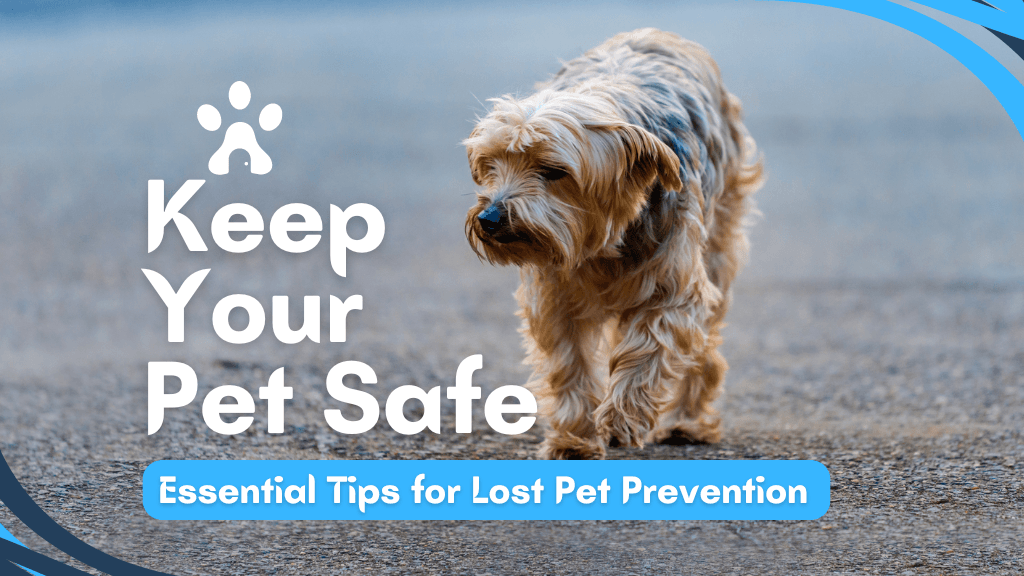Ensure Your Pet Safety : Essential Tips To Prevent Them from Getting Lost
)
Being a pet owner brings immense joy, but with that comes the responsibility of keeping your beloved companion safe. In Australia, thousands of pets go missing every year, leaving their owners heartbroken. July, recognised as National Lost Pet Prevention Month, reminds us of the importance of taking proactive steps to prevent this distressing situation.
We understand how much your pet means to you. In this guide, we’ll outline key measures you can take to keep your furry friend safe and reduce the risk of them getting lost.
Why Pets Go Missing: Common Triggers
Before implementing strategies to prevent your pet from wandering off, it’s important to understand why they might stray in the first place:
- Unfamiliar Environments: Strange noises, new scents, or unfamiliar animals in the area can make pets feel uneasy, causing them to run in search of safety.
- Home Security Gaps: Pets often find escape routes through unsecured fences, windows, or doors.
- Fear and Panic: Stressful events like thunderstorms, fireworks, or even separation anxiety may trigger a flight response, leading pets to bolt.
- Natural Instincts: Pets that haven’t been spayed or neutered are more likely to wander in search of a mate, increasing the risk of them getting lost.
The Importance of Proper Identification
Identification is the most effective way to ensure your pet is returned to you if they go missing. Here are the two main types of pet identification:
- Collar and ID Tag: Your pet should always wear a collar with an ID tag that includes up-to-date contact information, even if they are primarily an indoor pet. The tag should list your phone number and address, providing a quick and easy way for someone to contact you if your pet is found.
- Microchipping: A microchip provides a permanent, reliable form of identification that can’t be lost. This small device, implanted under your pet’s skin, stores a unique identification number that can be scanned by veterinarians and shelters. Make sure to keep your contact details in the microchip registry current to improve the chances of a safe reunion.
Home Security: How to Pet-Proof Your Property
A critical part of preventing your pet from escaping is securing your home:
- Check Your Fence Regularly: Look for any gaps, holes, or weak spots that might allow your pet to squeeze through or dig under. If necessary, install barriers such as wire mesh along the fence line to prevent digging.
- Secure Windows and Doors: Ensure that all windows have strong, intact screens, and that doors and gates are fitted with secure locks. Even the most obedient pet may be tempted to run if they see an open window or door.
- Watch Out for Escape Artists: If your pet has a history of escaping, take extra precautions, such as tethering them on a long lead when outdoors, but always under supervision to avoid injury.
Managing Stressful Situations: Keeping Your Pet Calm
Many pets try to escape when they’re stressed or anxious, particularly during noisy or chaotic events:
- Create a Safe Space: Set up a quiet, secure room in your home where your pet can retreat during stressful events like parties, deliveries, or fireworks. This space should have bedding, toys, food, and water to help keep them comfortable and relaxed.
- Desensitisation Training: If your pet has severe anxiety triggered by specific sounds like storms or fireworks, desensitisation training may help. This technique, often guided by a professional trainer, involves gradually exposing your pet to the sounds in a controlled environment, helping them build tolerance and reduce their fear over time.
Spaying and Neutering: Why It’s Important
Spaying or neutering your pet has multiple benefits, including reducing their desire to roam in search of a mate. Pets that have not been desexed are more likely to wander off, increasing the risk of them getting lost or injured. Additionally, desexing offers several health benefits, such as preventing certain types of cancers and improving overall well-being.
Training for Safety: Building a Trustworthy Pet
Obedience training is a key component of lost pet prevention. Teaching your pet basic commands such as “come,” “stay,” and “sit” can be life-saving, particularly in outdoor environments where they might encounter distractions or threats. A well-trained pet is less likely to run off when startled and more likely to return when called.
What to Do If Your Pet Goes Missing
Even with the best preventative measures in place, pets can still go missing. Here’s what to do if it happens:
- Start Your Search Immediately: Begin by searching your immediate area and calling your pet’s name. Check familiar hiding spots and ask your neighbours if they’ve seen your pet.
- Contact Local Shelters and Vets: Notify local animal shelters, vet clinics, and animal control agencies as soon as possible. Share your pet’s microchip information, a description, and a recent photo.
- Leverage Social Media: Post on local community groups and lost pet pages on social media platforms. Include clear pictures of your pet and details like their last known location, any distinguishing features, and your contact information.
At Baybreeze Veterinary, we’re passionate about helping you keep your pet safe and secure. We offer microchipping services, as well as advice on desensitisation training and other preventative measures.
Contact us today to schedule an appointment and learn more about how we can support your pet’s well-being.
&geometry(269x80))





